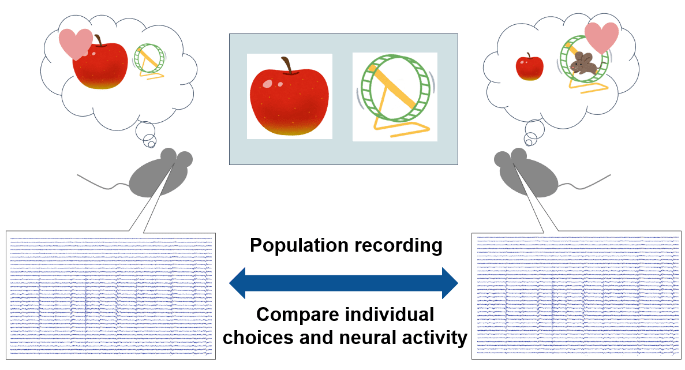Progress Report
Maximizing well-being and agency on the basis of interpersonal comparison of brain indicators[5] Comprehensive understanding of subjective reward value representation in rodent brain for interindividual comparison
Progress until FY2024
1. Outline of the project
We record brain activity using wide-field imaging and dense electrode arrays in behaving animals. This approach reveals the rewards and motivational states that the animals currently experience. We also design behavioral tasks that clarify the neural basis of learning and decision making.

2. Outcome so far
(1) Using a classical-conditioning paradigm, we quantified neural representations of the subjective value of water in rodents. A brief auditory cue consistently preceded the delivery of a water droplet, and animals rapidly acquired anticipatory licking. Viral delivery of a genetically engineered calcium indicator enabled cortex-wide fluorescence imaging, which we combined with ultra-dense silicon probe recordings to sample hundreds of neurons concurrently. Population analyses revealed neural coding of the reward and its predictive cue; moreover, activity patterns were reorganized as animals progressed from thirst to satiety, indicating that cortical and subcortical circuits dynamically update internal value estimates in accordance with motivational state.

(2) We study how reward pursuit drives action in rats. Because the animals cannot verbalize their state, we train them to “report” motivation by learning a two-choice task and selecting the option they value more. During performance we capture large-scale neural activity with cortex-wide imaging and ultra-dense electrodes, revealing how context and experience sculpt reward coding. To extend the approach, we are building a head-fixed virtual-reality arena that runs the same experiments in richer, controllable environments.

3. Future plans
We will record the neural representation of subjective reward value at high density and resolution, transiently shifting that value to track how brain activity changes. We will design new tasks that probe motivational drive, and develop theory for comparing value-related neural codes across individual animals.
(TANAKA Yasuhiro: Tamagawa University)